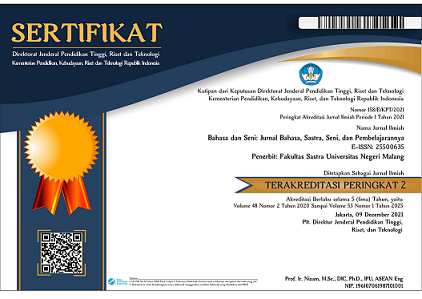New entry proposal in a dictionary: A case study for the entry lotus
Abstract
New entry proposal in a dictionary: A case study for the entry lotus
The object of this study is the word lotus. In the Comprehensive Indonesian Dictionary (KBBI), the lotus entry has only one meaning within the botanical domain. However, the word lotus is also present and used in the context of Buddhism in Indonesia. Based on this fact, it is suggested to add a new meaning to the entry. The problem is to decide whether the new meaning is a polysemy or a homonym, and the criteria used to determine this. The purpose of this research is to provide input to the Language Development and Fostering Agency to add new word entries to the KBBI using a case study of the word 'lotus' entry. Our research results on the word 'lotus' can expand the knowledge of the Indonesian people from the domain of botany to the domain of religion. In order to determine whether the entry is a polysemy or a homonym is carried out through Peirce's semiotic theory developed by Ogden and Richards to examine the relationship between three components that make up the word lotus as a sign. The research method involves analyzing the difference between the basic meaning and the new meaning, whether there is a development of a new meaning or a completely different meaning from the basic meaning. Unlike the previous studies, this research views meaning as a sign component. The lotus entry is a sign consisting of symbol, thought or reference, and reference components.
Proposal entri baru dalam kamus: Studi kasus untuk entri teratai
Objek penelitian ini adalah kata teratai. Dalam Kamus Besar Bahasa Indonesia (KBBI), entri teratai hanya memiliki satu arti dalam domain botani. Namun, kata teratai juga hadir dan digunakan dalam konteks agama Buddha di Indonesia. Berdasarkan fakta ini, disarankan untuk menambahkan arti baru. Persoalannya adalah apakah makna baru tersebut merupakan polisemi atau homonim, dan kriteria apa yang digunakan untuk menentukan entri sebagai polisemi atau homonim. Tujuan dari penelitian ini adalah untuk memberikan masukan kepada Badan Pengembangan dan Pembinaan Bahasa untuk menambahkan entri kata baru untuk KBBI dengan menggunakan studi kasus dari entri kata teratai. Hasil penelitian dari kata teratai dalam studi ini dapat memperluas pengetahuan masyarakat Indonesia dari ranah botani ke ranah religi. Penentuan bahwa kata ini merupakan sebuah polisemi atau homonim dilakukan melalui teori semiotika Peirce yang dikembangkan oleh Ogden dan Richards untuk mengkaji hubungan antara tiga komponen yang membentuk kata teratai sebagai tanda. Metode penelitian ini melibatkan analisis perbedaan antara makna dasar dan makna baru, apakah ada pengembangan makna baru atau makna yang sama sekali berbeda dari makna dasar. Berbeda dengan penelitian sebelumnya, penelitian ini memandang makna sebagai komponen tanda. Entri teratai adalah tanda yang terdiri dari simbol, pemikiran atau referensi, dan komponen referensi.
Full Text:
PDFReferences
Chen, Y. (2012). 英汉植物隐喻的跨文化理解研究. (Cross-cultural understanding of plant meta-phor in Chinese and English). East Chinese Normal University Press.
Chinese as a Second Language Research. (n.d.). Retrieved 28 January 2022, from https://www.degruyter.com/journal/key/caslar/html
Ding, Y. (2020). 汉语植物词语研究 . 内蒙古大学. (Research on Chinese plant words). Inner Mongolia University Press.
Finnegan, E. G. (1975). New Websters’s dictionary of the English language. Consolidated Book.
Ge, B. (2006). 汉语词汇研究. 外语教学与研究出版社 (Chinese vocabulary research). Foreign Language Teaching and Research Press
Hornby, A. S. (2010). Oxford Advanced Learner’s Dictionary international student’s edition. Oxford University Press.
Jia, J. (2011). 植物意象研究 . 东北林业大学.(Research on plant imagery). Northeast Forestry University Press.
Kementerian Pendidikan dan Kebudayaan. (2017). Pendidikan agama Buddha dan Budi Pekerti/ Kementerian Pendidikan dan Kebudayaan. Kementerian Pendidikan dan Ke-budayaan.
Li, H. (2021). 基于符号学理论的园林景观表现形式解析. Journal of Agricultural Technology and Equipment, Analysis of the Expression Form of Landscape based on Semiotics Theory, 04(2), 128–129. https://doi.org/CNKI:SUN:NJTU.0.2021-04-060
Li, M. X., & Song, L. (2010). 符号学视阈下的花语. 黑龙江教育学院学报, Journal of Heilongjiang Institute of Education, 05, 112–114. https://doi.org/CNKI:SUN:HLJB.0.2010-05-041(Flower language from the perspective of semiotics)
Lianhua(lotus) Center of Chinese Linguistics. (n.d.). Retrieved 30 August 2022, from http://ccl.pku.edu.cn:8080/ccl_corpus/search?q=%E8%8E%B2%E8%8A%B1&start=0&num=50&index=FullIndex&outputFormat=HTML&encoding=UTF-8&maxLeftLength=30&maxRightLength=30&orderStyle=score&LastQuery=&dir=xiandai&scopestr=
Mugglestone, L. C. (2010). Much intoxication but little restraint. Reconstructing history through the historical thesaurus of the Oxford English Dictionary. Language & History, 53(2), 138–143. https://doi.org/10.1179/175975310X12798962415341
Paramasuta, R., & Kabul, A. R. (2022). Makna nama tionghoa dan harapan orangtua. Jurnal Cakrawala Mandarin, 5(2), 110–129. https://doi.org/10.36279/apsmi.v5i2.135
Roget, P. M., Roget, J. L., & Roget, S. R. (1979). Roget’s Thesaurus of English words and phrases. Chartwell Books.
Semantik leksikal/Mansoer Pateda | OPAC Perpustakaan Nasional RI. (n.d.). Retrieved 26 July 2022, from https://opac.perpusnas.go.id/DetailOpac.aspx?id=558851
Sriti Mayang, S., & Pramono, R. S. (2008). Kajian ikonografis ornamen pada interior klenteng Sanggar Agung Surabaya. Dimensi Interior, 6(2), 73–84. https://doi.org/10.9744/interior.6.2.
Sulan, S., & Darma, N. S. (2017). Pendidikan agama Buddha dan budi pekerti: Buku siswa SD kelas I. In B. B. U. D. Sampanno, P. N. Suryanadi, G. E. Susanto, & M. Mujiyanto (Eds.). Kementrian Pendidikan dan Kebudayaan. http://repositori.kemdikbud.go.id/6930/
Sutami, H. (1999). Ikonisitas dalam sintaksis bahasa Mandarin, [Doctoral Dissertation, Uni-versitas Indonesia].
Su X. (2010). 关于《现代汉语词典》词汇计量研究的思考. Journal of Chinese Teaching in the World, 05, 112–114. https://doi.org/doi:CNKI:SUN:HLJB.0.2010-05-041
Su, X. (2013). 现代汉语分类词典. 商务印书馆. A thesaurus of Modern Chinese. Commercial Press.
Su X., Hong, G., & Tang S. (2010). 再论义类词典的分类原则与方法. (Rediscussion on the classi-fication principles and methods of semantic dictionaries). Journal of Chinese Teaching in the World, 24(02), 158–169. https://doi.org/doi:10.13724/j.cnki.ctiw.2010.02.002
Wiratikusuma, F. (2020). 一部有益于印度尼西亚汉语学习者的词汇工具书——评《现代汉语分类词典》. 江西科技师范大学学报, 01, 23-28+22. https://doi.org/CNKI:SUN:NZJS.0.2020-01-004
Wiratikusuma, F. (2021). A thesaurus of Modern Chinese (TMC) for Chinese language learner in vocabulary learning (Tesaurus China Modern (TCM) untuk pemelajar bahasa China dalam pemelajaran kosakata). Metalingua: Jurnal Penelitian Bahasa, 19(1), 51–62. https://doi.org/10.26499/metalingua.v19i1.706
DOI: http://dx.doi.org/10.17977/um015v50i22022p274
Refbacks
- There are currently no refbacks.

This work is licensed under a Creative Commons Attribution 4.0 International License.

Dear Sir/Madam
We appreciate your continued confidence and trust in Bahasa dan Seni: Jurnal Bahasa, Sastra, Seni, dan Pengajarannya (JBS). In order to enhance the service, readability, and quality of JBS publications, we will be transitioning to a new website, https://citeus.um.ac.id/jbs, in collaboration with Digital Commons (Elsevier) starting in July 2024.
Sincerely
Yusuf Hanafi
(Editor in chief)















2.png)